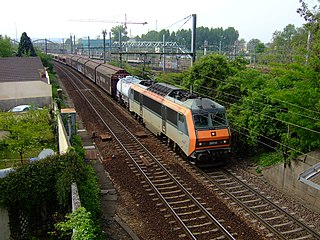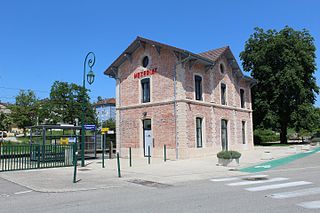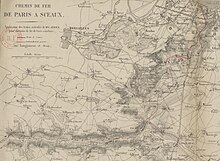
The Gare de Lyon, officially Paris Gare de Lyon, is one of the seven large mainline railway stations in Paris, France. It handles about 148.1 million passengers annually according to the estimates of the SNCF in 2018, with SNCF railways and the RER D accounting for around 110 million and the RER A accounting for 38 million, making it the second-busiest station of France after the Gare du Nord and one of the busiest in Europe.

Gare d'Austerlitz, officially Paris Austerlitz, is one of the seven large Paris railway terminal stations. The station is located on the left bank of the Seine in the southeastern part of the city, in the 13th arrondissement. It is the start of the Paris–Bordeaux railway; the line to Toulouse is connected to this line. In 1997, the Ministry of Culture designated the Gare d'Austerlitz a historical monument; it became the fifth large railway station in Paris to receive such a label, as currently only Montparnasse has not been attributed it.

The Gare d'Orsay is a former Paris railway station and hotel, built in 1900 to designs by Victor Laloux, Lucien Magne and Émile Bénard; it served as a terminus for the Chemin de Fer de Paris à Orléans. It was the first electrified urban terminal station in the world, opened 28 May 1900, in time for the 1900 Exposition Universelle.

The Compagnie des chemins de fer du Midi, also known in English as the Midi or Southern Railway, was an early French railway company which operated a network of routes in the southwest of the country, chiefly in the area between its main line – which ran from Bordeaux, close to the Atlantic coast, to Sète on the Mediterranean – and the Pyrenees.

Port-Royal station is a French railway station on the RER B line in Paris. It is located in the 5th arrondissement, not far from its tripoint border with the 6th and 14th arrondissements. It is named after Port-Royal Abbey, Paris.

Musée d'Orsay is a station in line C of the Paris Region's Réseau Express Régional (RER) rapid transit system, named after the Musée d'Orsay, housed in the former Gare d'Orsay. It is in the 7th arrondissement of Paris, on the Quai Anatole-France. It was one of several stations attacked during the 1995 Paris Métro and RER bombings.

RER B is one of the five lines in the Réseau Express Régional, a hybrid commuter rail and rapid transit system serving Paris, France and its Île-de-France suburbs. The 80-kilometre (50 mi) RER B line crosses the region from north to south, with all trains serving a group of stations in central Paris, before branching out towards the ends of the line.
The Compagnie des chemins de fer de l'Ouest, often referred to simply as L'Ouest or Ouest, was an early French railway company which operated from the years 1855 through 1909.

Denfert-Rochereau station is a railway station in Paris. It was one of the first stations of the French railway network, and is still in use as a station of Paris' RER line B.

The Grande Ceinture line is a railway line around Paris, located 15 kilometres (9.3 mi) from the Boulevard Périphérique. The decision to build it was taken at the end of the 19th century, to connect the radial lines linking the capital to the provinces and provide relief to the busy Petite Ceinture Line.

The Arnoux system is a train articulation system, for turning on railroad tracks, invented by Jean-Claude-Républicain Arnoux and patented in France in 1838. Arnoux was the chief engineer of the Ligne de Sceaux, which was originally built with very tight radii in the area around Sceaux, Hauts-de-Seine.

Épinay - Villetaneuse is a railway station located in the commune of Épinay-sur-Seine, Seine-Saint-Denis department, France. It is also adjacent to the communes of Montmagny and Deuil-la-Barre in Val d'Oise.

The Persan–Beaumont station is a railway station in Persan, France, near Beaumont-sur-Oise. It is at the junction of the Épinay-Villetaneuse–Le Tréport-Mers railway and the Pierrelaye–Creil railway. The station is served by trains of the Transilien line H and the TER Hauts-de-France.

Bourg-la-Reine station is a railway station on the Sceaux line, located in the town of Bourg-la-Reine, Hauts-de-Seine, France.

The SNCF BB 1280 class were a class of 600 V DC 4 axle Bo′Bo′ electric locomotives, formerly Compagnie du chemin de fer de Paris à Orléans machines, initially built for an underground section of line connecting the Gare d'Austerlitz to the Quai d'Orsay in inner Paris. The locomotives were converted for 1500 V DC use in the 1930s, and renumbered PO E.281 to E.293. They were absorbed by the SNCF, and operated as shunters until the late 1960s.
Jean-Claude-Républicain Arnoux was a French civil engineer known for his invention of the Arnoux system for articulating trains on tight curves. As an entrepreneur he founded and directed the Compagnie de Paris à Orsay, which constructed and operated the line from Paris to Orsay and is now part of the Ligne de Sceaux. It opened on 6 June 1846.

Saverne station is a French railway station located on the Noisy-le-Sec–Strasbourg railway. It is located within the commune of Saverne, in departement Bas-Rhin, in northeastern France.

Gare de Molsheim is a French railway station located on the Strasbourg—Saint-Dié and Sélestat–Saverne railways. It is located within the commune of Molsheim, in the Bas-Rhin department, in northeastern France.

The Z 23000 was a type of passenger train used by the Compagnie du Chemin de Fer Métropolitain de Paris (CMP).

Mézériat station is a railway station located in the commune of Mézériat, Ain department in the Auvergne-Rhône-Alpes region of France. It is located at kilometric point (KP) 21.476 on the Mâcon—Ambérieu railway, between the stations of Vonnas and Polliat.




























